Critical Reflective Writing: Tuckman's Stages of Team Development
VerifiedAdded on 2020/10/22
|8
|1881
|423
Essay
AI Summary
This essay offers a critical reflection on team development, focusing on Bruce Tuckman's stages of group development: forming, storming, norming, performing, and adjourning. It analyzes the advantages and disadvantages of self-managed teams, emphasizing the importance of conflict resolution techniques like collaboration. The essay explores various team roles, such as expert, shadow, judge, peace maker, and brainstormer, within the context of a project team with members from diverse cultural backgrounds. It highlights the significance of clear communication, respect for differing opinions, and the effective application of norms to achieve team goals. The conclusion underscores the value of teamwork and the structured approach provided by Tuckman's model for successful project completion.
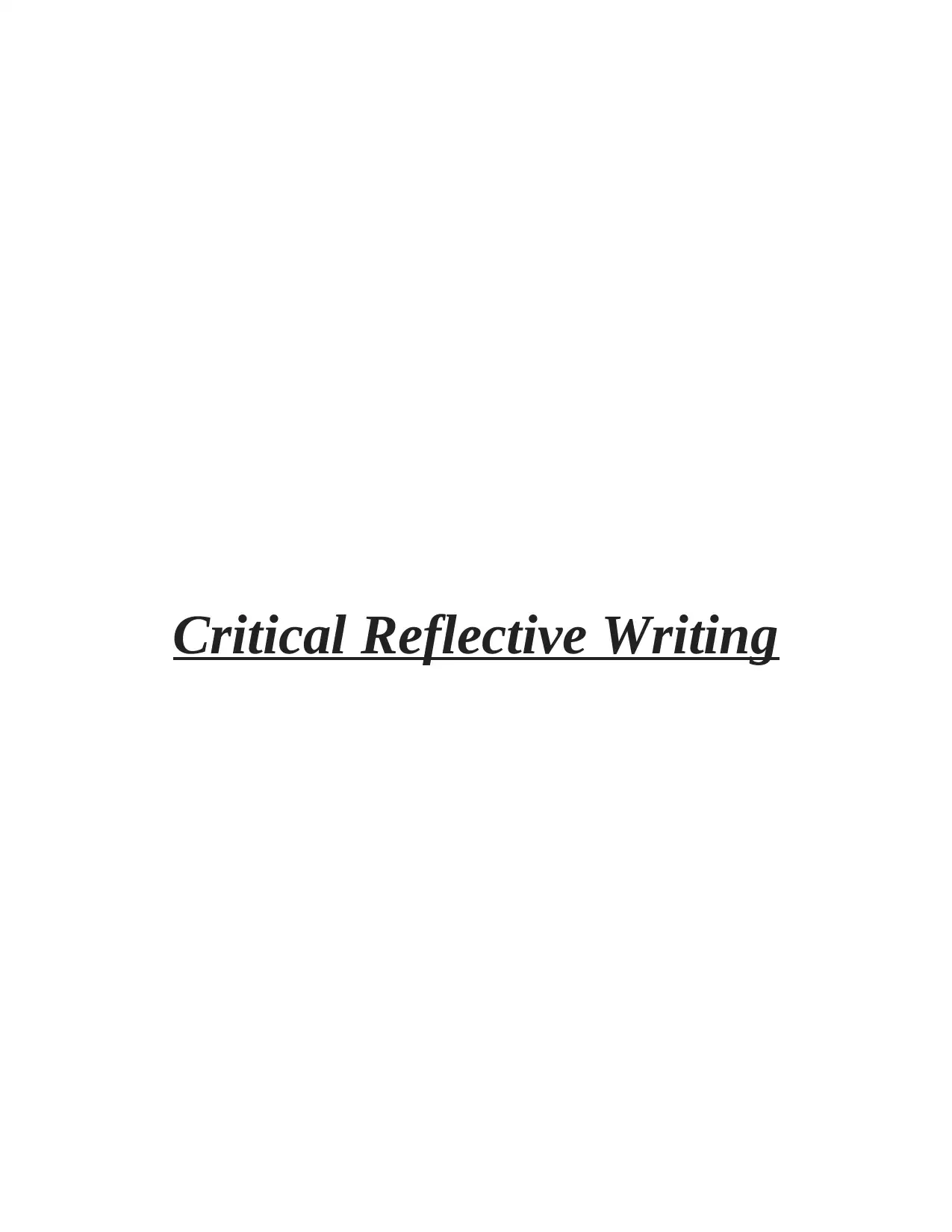
Critical Reflective Writing
Paraphrase This Document
Need a fresh take? Get an instant paraphrase of this document with our AI Paraphraser
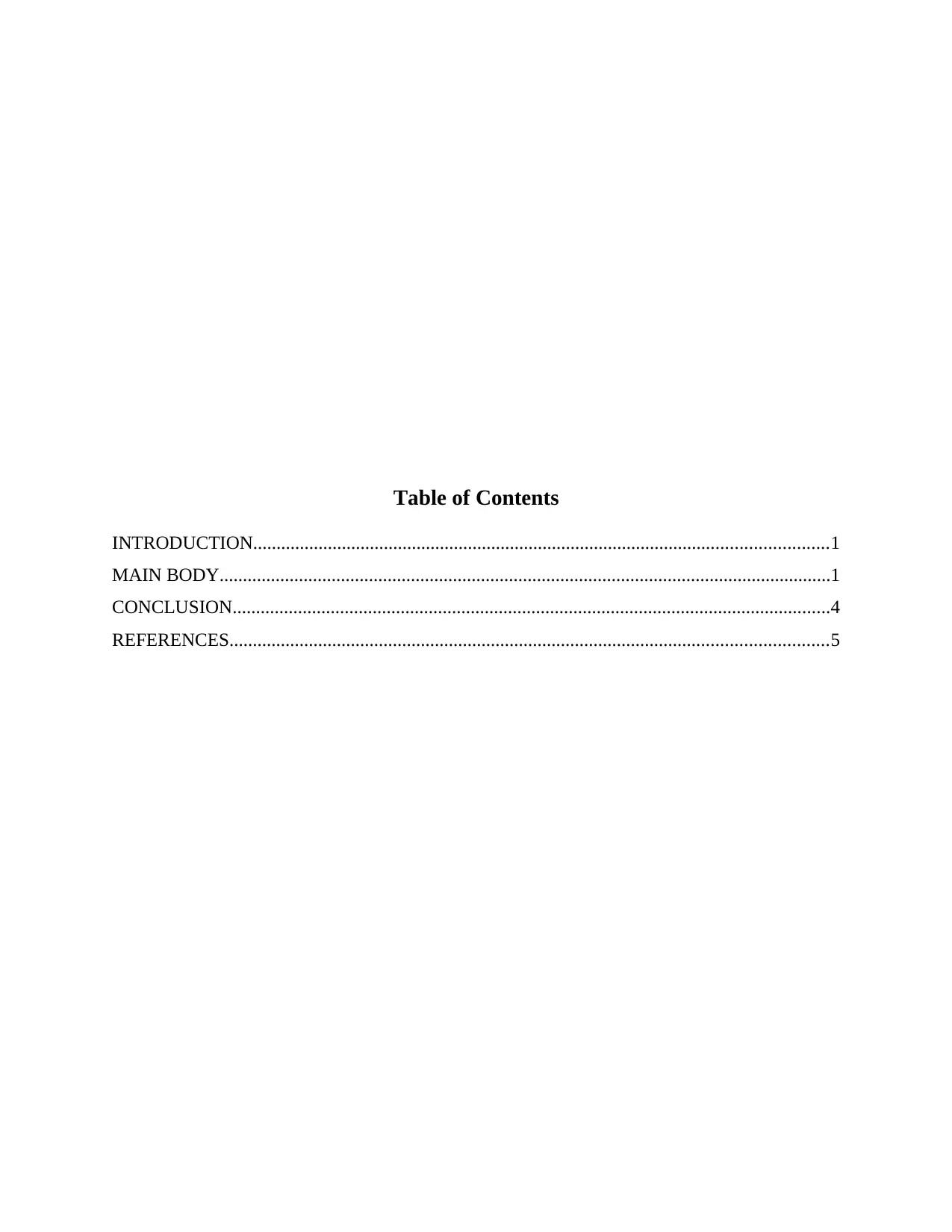
Table of Contents
INTRODUCTION...........................................................................................................................1
MAIN BODY...................................................................................................................................1
CONCLUSION................................................................................................................................4
REFERENCES................................................................................................................................5
INTRODUCTION...........................................................................................................................1
MAIN BODY...................................................................................................................................1
CONCLUSION................................................................................................................................4
REFERENCES................................................................................................................................5

⊘ This is a preview!⊘
Do you want full access?
Subscribe today to unlock all pages.

Trusted by 1+ million students worldwide
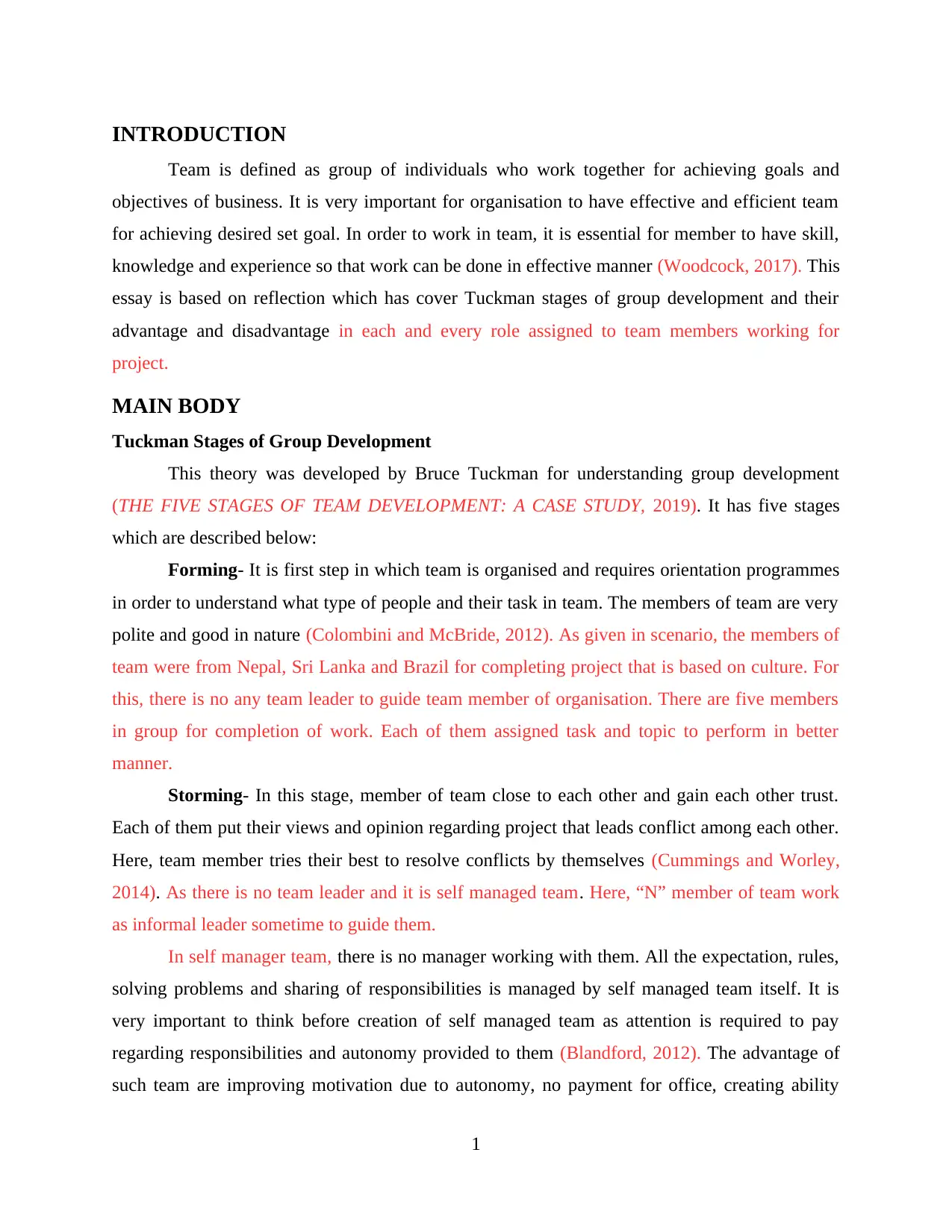
INTRODUCTION
Team is defined as group of individuals who work together for achieving goals and
objectives of business. It is very important for organisation to have effective and efficient team
for achieving desired set goal. In order to work in team, it is essential for member to have skill,
knowledge and experience so that work can be done in effective manner (Woodcock, 2017). This
essay is based on reflection which has cover Tuckman stages of group development and their
advantage and disadvantage in each and every role assigned to team members working for
project.
MAIN BODY
Tuckman Stages of Group Development
This theory was developed by Bruce Tuckman for understanding group development
(THE FIVE STAGES OF TEAM DEVELOPMENT: A CASE STUDY, 2019). It has five stages
which are described below:
Forming- It is first step in which team is organised and requires orientation programmes
in order to understand what type of people and their task in team. The members of team are very
polite and good in nature (Colombini and McBride, 2012). As given in scenario, the members of
team were from Nepal, Sri Lanka and Brazil for completing project that is based on culture. For
this, there is no any team leader to guide team member of organisation. There are five members
in group for completion of work. Each of them assigned task and topic to perform in better
manner.
Storming- In this stage, member of team close to each other and gain each other trust.
Each of them put their views and opinion regarding project that leads conflict among each other.
Here, team member tries their best to resolve conflicts by themselves (Cummings and Worley,
2014). As there is no team leader and it is self managed team. Here, “N” member of team work
as informal leader sometime to guide them.
In self manager team, there is no manager working with them. All the expectation, rules,
solving problems and sharing of responsibilities is managed by self managed team itself. It is
very important to think before creation of self managed team as attention is required to pay
regarding responsibilities and autonomy provided to them (Blandford, 2012). The advantage of
such team are improving motivation due to autonomy, no payment for office, creating ability
1
Team is defined as group of individuals who work together for achieving goals and
objectives of business. It is very important for organisation to have effective and efficient team
for achieving desired set goal. In order to work in team, it is essential for member to have skill,
knowledge and experience so that work can be done in effective manner (Woodcock, 2017). This
essay is based on reflection which has cover Tuckman stages of group development and their
advantage and disadvantage in each and every role assigned to team members working for
project.
MAIN BODY
Tuckman Stages of Group Development
This theory was developed by Bruce Tuckman for understanding group development
(THE FIVE STAGES OF TEAM DEVELOPMENT: A CASE STUDY, 2019). It has five stages
which are described below:
Forming- It is first step in which team is organised and requires orientation programmes
in order to understand what type of people and their task in team. The members of team are very
polite and good in nature (Colombini and McBride, 2012). As given in scenario, the members of
team were from Nepal, Sri Lanka and Brazil for completing project that is based on culture. For
this, there is no any team leader to guide team member of organisation. There are five members
in group for completion of work. Each of them assigned task and topic to perform in better
manner.
Storming- In this stage, member of team close to each other and gain each other trust.
Each of them put their views and opinion regarding project that leads conflict among each other.
Here, team member tries their best to resolve conflicts by themselves (Cummings and Worley,
2014). As there is no team leader and it is self managed team. Here, “N” member of team work
as informal leader sometime to guide them.
In self manager team, there is no manager working with them. All the expectation, rules,
solving problems and sharing of responsibilities is managed by self managed team itself. It is
very important to think before creation of self managed team as attention is required to pay
regarding responsibilities and autonomy provided to them (Blandford, 2012). The advantage of
such team are improving motivation due to autonomy, no payment for office, creating ability
1
Paraphrase This Document
Need a fresh take? Get an instant paraphrase of this document with our AI Paraphraser
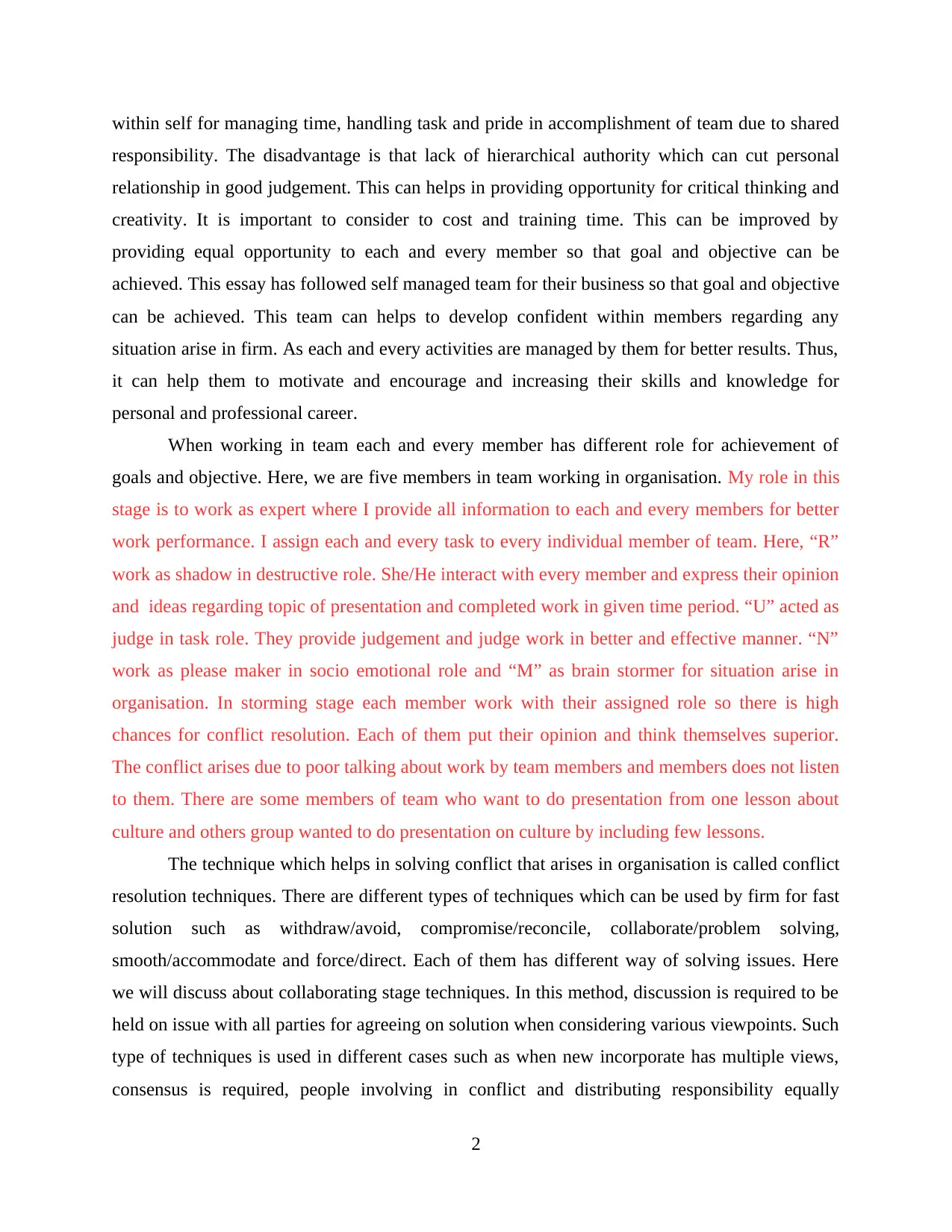
within self for managing time, handling task and pride in accomplishment of team due to shared
responsibility. The disadvantage is that lack of hierarchical authority which can cut personal
relationship in good judgement. This can helps in providing opportunity for critical thinking and
creativity. It is important to consider to cost and training time. This can be improved by
providing equal opportunity to each and every member so that goal and objective can be
achieved. This essay has followed self managed team for their business so that goal and objective
can be achieved. This team can helps to develop confident within members regarding any
situation arise in firm. As each and every activities are managed by them for better results. Thus,
it can help them to motivate and encourage and increasing their skills and knowledge for
personal and professional career.
When working in team each and every member has different role for achievement of
goals and objective. Here, we are five members in team working in organisation. My role in this
stage is to work as expert where I provide all information to each and every members for better
work performance. I assign each and every task to every individual member of team. Here, “R”
work as shadow in destructive role. She/He interact with every member and express their opinion
and ideas regarding topic of presentation and completed work in given time period. “U” acted as
judge in task role. They provide judgement and judge work in better and effective manner. “N”
work as please maker in socio emotional role and “M” as brain stormer for situation arise in
organisation. In storming stage each member work with their assigned role so there is high
chances for conflict resolution. Each of them put their opinion and think themselves superior.
The conflict arises due to poor talking about work by team members and members does not listen
to them. There are some members of team who want to do presentation from one lesson about
culture and others group wanted to do presentation on culture by including few lessons.
The technique which helps in solving conflict that arises in organisation is called conflict
resolution techniques. There are different types of techniques which can be used by firm for fast
solution such as withdraw/avoid, compromise/reconcile, collaborate/problem solving,
smooth/accommodate and force/direct. Each of them has different way of solving issues. Here
we will discuss about collaborating stage techniques. In this method, discussion is required to be
held on issue with all parties for agreeing on solution when considering various viewpoints. Such
type of techniques is used in different cases such as when new incorporate has multiple views,
consensus is required, people involving in conflict and distributing responsibility equally
2
responsibility. The disadvantage is that lack of hierarchical authority which can cut personal
relationship in good judgement. This can helps in providing opportunity for critical thinking and
creativity. It is important to consider to cost and training time. This can be improved by
providing equal opportunity to each and every member so that goal and objective can be
achieved. This essay has followed self managed team for their business so that goal and objective
can be achieved. This team can helps to develop confident within members regarding any
situation arise in firm. As each and every activities are managed by them for better results. Thus,
it can help them to motivate and encourage and increasing their skills and knowledge for
personal and professional career.
When working in team each and every member has different role for achievement of
goals and objective. Here, we are five members in team working in organisation. My role in this
stage is to work as expert where I provide all information to each and every members for better
work performance. I assign each and every task to every individual member of team. Here, “R”
work as shadow in destructive role. She/He interact with every member and express their opinion
and ideas regarding topic of presentation and completed work in given time period. “U” acted as
judge in task role. They provide judgement and judge work in better and effective manner. “N”
work as please maker in socio emotional role and “M” as brain stormer for situation arise in
organisation. In storming stage each member work with their assigned role so there is high
chances for conflict resolution. Each of them put their opinion and think themselves superior.
The conflict arises due to poor talking about work by team members and members does not listen
to them. There are some members of team who want to do presentation from one lesson about
culture and others group wanted to do presentation on culture by including few lessons.
The technique which helps in solving conflict that arises in organisation is called conflict
resolution techniques. There are different types of techniques which can be used by firm for fast
solution such as withdraw/avoid, compromise/reconcile, collaborate/problem solving,
smooth/accommodate and force/direct. Each of them has different way of solving issues. Here
we will discuss about collaborating stage techniques. In this method, discussion is required to be
held on issue with all parties for agreeing on solution when considering various viewpoints. Such
type of techniques is used in different cases such as when new incorporate has multiple views,
consensus is required, people involving in conflict and distributing responsibility equally
2
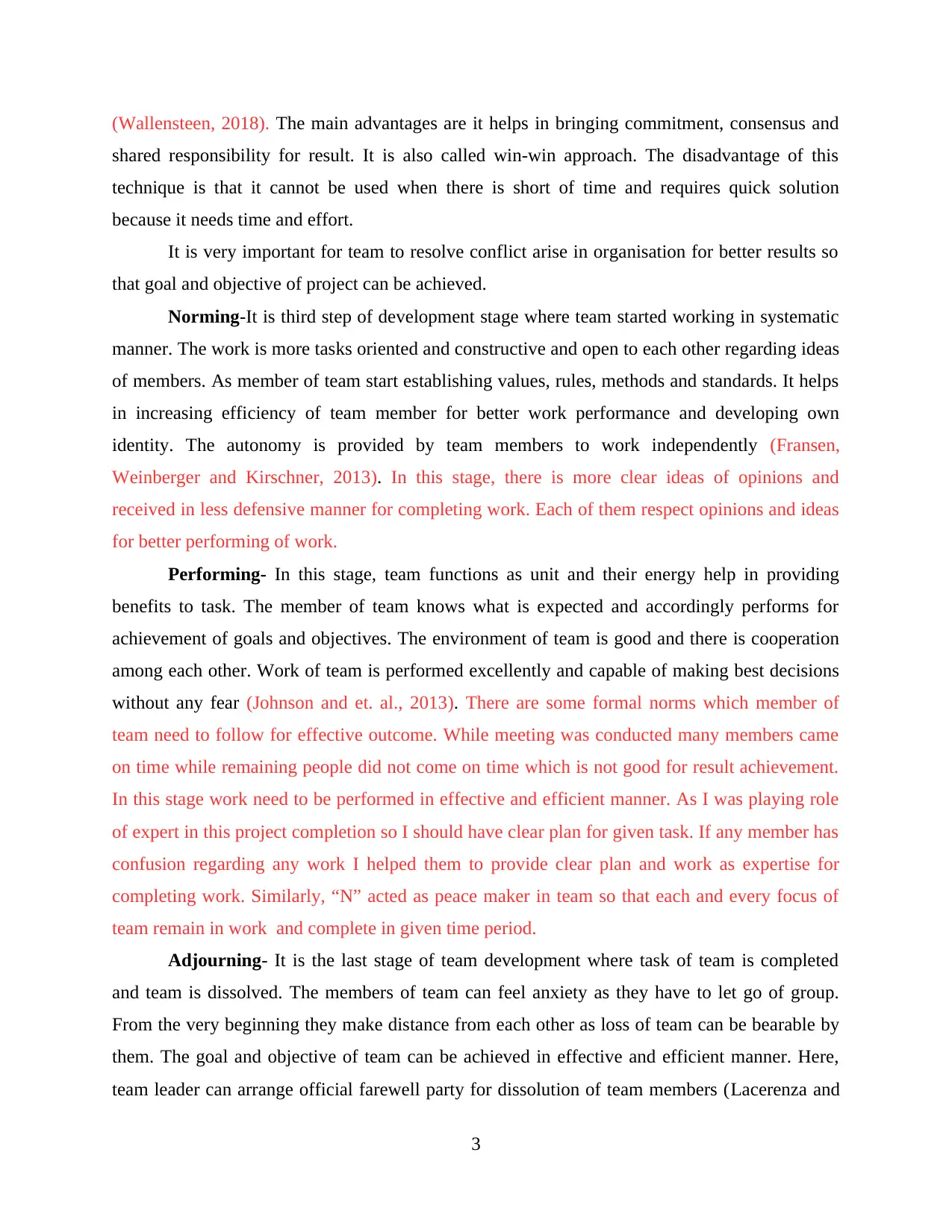
(Wallensteen, 2018). The main advantages are it helps in bringing commitment, consensus and
shared responsibility for result. It is also called win-win approach. The disadvantage of this
technique is that it cannot be used when there is short of time and requires quick solution
because it needs time and effort.
It is very important for team to resolve conflict arise in organisation for better results so
that goal and objective of project can be achieved.
Norming-It is third step of development stage where team started working in systematic
manner. The work is more tasks oriented and constructive and open to each other regarding ideas
of members. As member of team start establishing values, rules, methods and standards. It helps
in increasing efficiency of team member for better work performance and developing own
identity. The autonomy is provided by team members to work independently (Fransen,
Weinberger and Kirschner, 2013). In this stage, there is more clear ideas of opinions and
received in less defensive manner for completing work. Each of them respect opinions and ideas
for better performing of work.
Performing- In this stage, team functions as unit and their energy help in providing
benefits to task. The member of team knows what is expected and accordingly performs for
achievement of goals and objectives. The environment of team is good and there is cooperation
among each other. Work of team is performed excellently and capable of making best decisions
without any fear (Johnson and et. al., 2013). There are some formal norms which member of
team need to follow for effective outcome. While meeting was conducted many members came
on time while remaining people did not come on time which is not good for result achievement.
In this stage work need to be performed in effective and efficient manner. As I was playing role
of expert in this project completion so I should have clear plan for given task. If any member has
confusion regarding any work I helped them to provide clear plan and work as expertise for
completing work. Similarly, “N” acted as peace maker in team so that each and every focus of
team remain in work and complete in given time period.
Adjourning- It is the last stage of team development where task of team is completed
and team is dissolved. The members of team can feel anxiety as they have to let go of group.
From the very beginning they make distance from each other as loss of team can be bearable by
them. The goal and objective of team can be achieved in effective and efficient manner. Here,
team leader can arrange official farewell party for dissolution of team members (Lacerenza and
3
shared responsibility for result. It is also called win-win approach. The disadvantage of this
technique is that it cannot be used when there is short of time and requires quick solution
because it needs time and effort.
It is very important for team to resolve conflict arise in organisation for better results so
that goal and objective of project can be achieved.
Norming-It is third step of development stage where team started working in systematic
manner. The work is more tasks oriented and constructive and open to each other regarding ideas
of members. As member of team start establishing values, rules, methods and standards. It helps
in increasing efficiency of team member for better work performance and developing own
identity. The autonomy is provided by team members to work independently (Fransen,
Weinberger and Kirschner, 2013). In this stage, there is more clear ideas of opinions and
received in less defensive manner for completing work. Each of them respect opinions and ideas
for better performing of work.
Performing- In this stage, team functions as unit and their energy help in providing
benefits to task. The member of team knows what is expected and accordingly performs for
achievement of goals and objectives. The environment of team is good and there is cooperation
among each other. Work of team is performed excellently and capable of making best decisions
without any fear (Johnson and et. al., 2013). There are some formal norms which member of
team need to follow for effective outcome. While meeting was conducted many members came
on time while remaining people did not come on time which is not good for result achievement.
In this stage work need to be performed in effective and efficient manner. As I was playing role
of expert in this project completion so I should have clear plan for given task. If any member has
confusion regarding any work I helped them to provide clear plan and work as expertise for
completing work. Similarly, “N” acted as peace maker in team so that each and every focus of
team remain in work and complete in given time period.
Adjourning- It is the last stage of team development where task of team is completed
and team is dissolved. The members of team can feel anxiety as they have to let go of group.
From the very beginning they make distance from each other as loss of team can be bearable by
them. The goal and objective of team can be achieved in effective and efficient manner. Here,
team leader can arrange official farewell party for dissolution of team members (Lacerenza and
3
⊘ This is a preview!⊘
Do you want full access?
Subscribe today to unlock all pages.

Trusted by 1+ million students worldwide
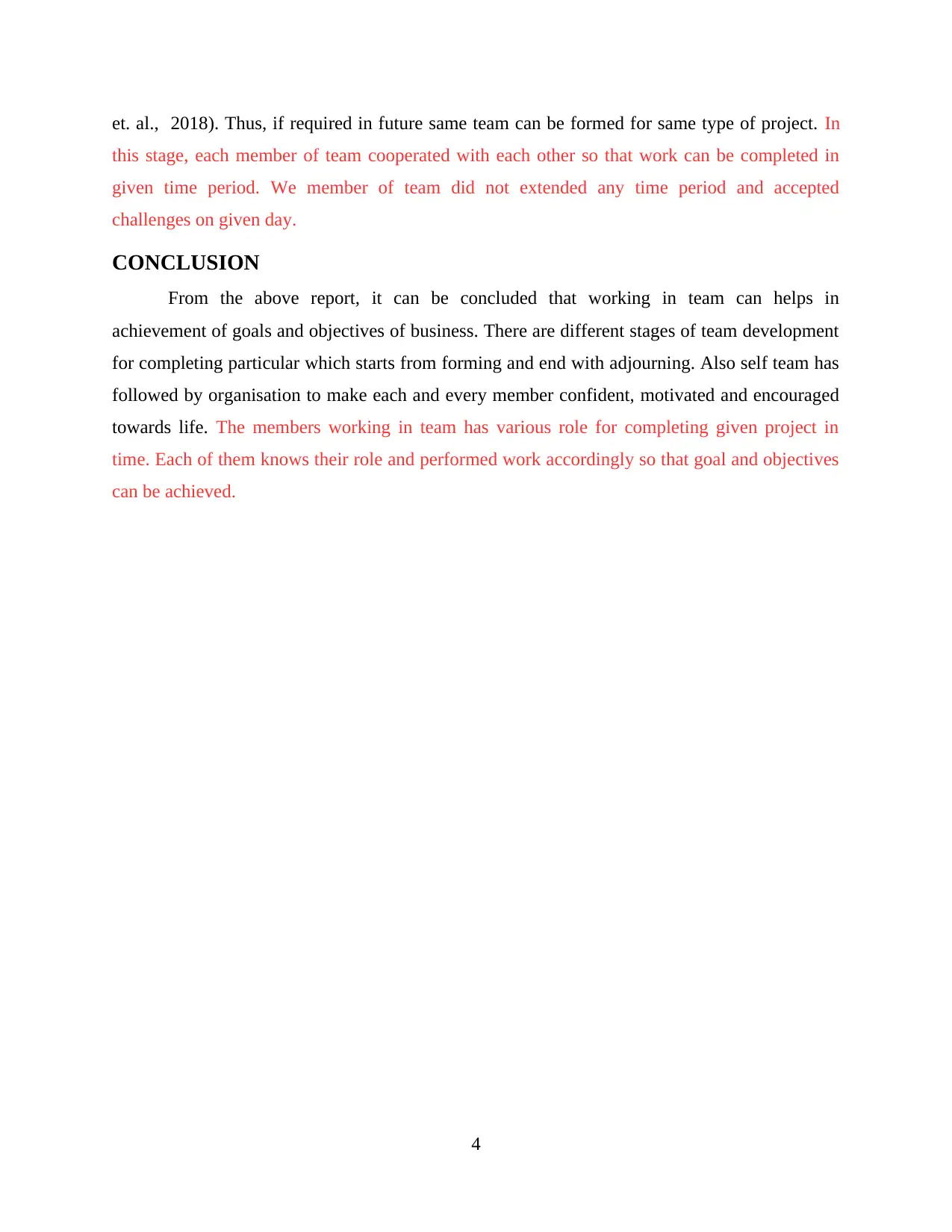
et. al., 2018). Thus, if required in future same team can be formed for same type of project. In
this stage, each member of team cooperated with each other so that work can be completed in
given time period. We member of team did not extended any time period and accepted
challenges on given day.
CONCLUSION
From the above report, it can be concluded that working in team can helps in
achievement of goals and objectives of business. There are different stages of team development
for completing particular which starts from forming and end with adjourning. Also self team has
followed by organisation to make each and every member confident, motivated and encouraged
towards life. The members working in team has various role for completing given project in
time. Each of them knows their role and performed work accordingly so that goal and objectives
can be achieved.
4
this stage, each member of team cooperated with each other so that work can be completed in
given time period. We member of team did not extended any time period and accepted
challenges on given day.
CONCLUSION
From the above report, it can be concluded that working in team can helps in
achievement of goals and objectives of business. There are different stages of team development
for completing particular which starts from forming and end with adjourning. Also self team has
followed by organisation to make each and every member confident, motivated and encouraged
towards life. The members working in team has various role for completing given project in
time. Each of them knows their role and performed work accordingly so that goal and objectives
can be achieved.
4
Paraphrase This Document
Need a fresh take? Get an instant paraphrase of this document with our AI Paraphraser
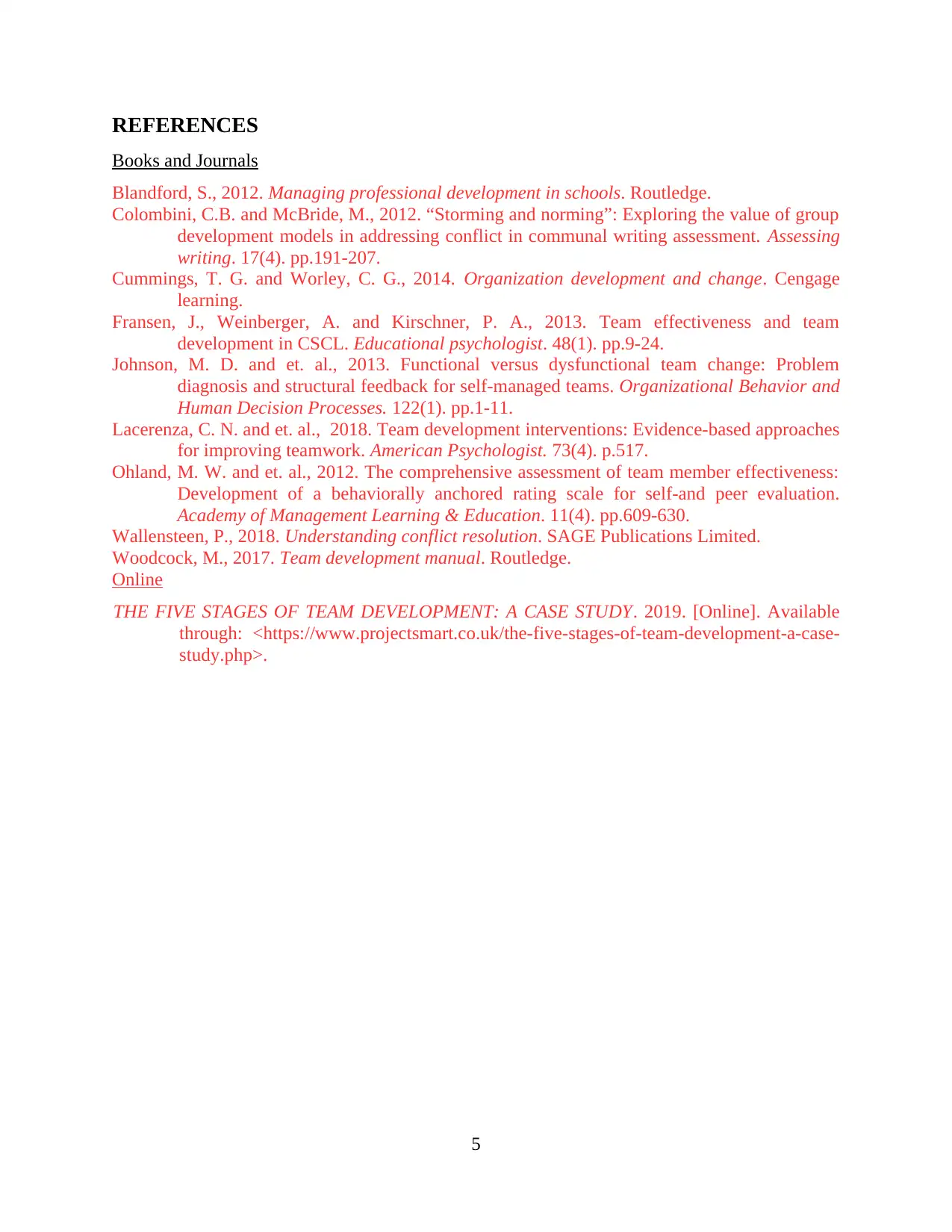
REFERENCES
Books and Journals
Blandford, S., 2012. Managing professional development in schools. Routledge.
Colombini, C.B. and McBride, M., 2012. “Storming and norming”: Exploring the value of group
development models in addressing conflict in communal writing assessment. Assessing
writing. 17(4). pp.191-207.
Cummings, T. G. and Worley, C. G., 2014. Organization development and change. Cengage
learning.
Fransen, J., Weinberger, A. and Kirschner, P. A., 2013. Team effectiveness and team
development in CSCL. Educational psychologist. 48(1). pp.9-24.
Johnson, M. D. and et. al., 2013. Functional versus dysfunctional team change: Problem
diagnosis and structural feedback for self-managed teams. Organizational Behavior and
Human Decision Processes. 122(1). pp.1-11.
Lacerenza, C. N. and et. al., 2018. Team development interventions: Evidence-based approaches
for improving teamwork. American Psychologist. 73(4). p.517.
Ohland, M. W. and et. al., 2012. The comprehensive assessment of team member effectiveness:
Development of a behaviorally anchored rating scale for self-and peer evaluation.
Academy of Management Learning & Education. 11(4). pp.609-630.
Wallensteen, P., 2018. Understanding conflict resolution. SAGE Publications Limited.
Woodcock, M., 2017. Team development manual. Routledge.
Online
THE FIVE STAGES OF TEAM DEVELOPMENT: A CASE STUDY. 2019. [Online]. Available
through: <https://www.projectsmart.co.uk/the-five-stages-of-team-development-a-case-
study.php>.
5
Books and Journals
Blandford, S., 2012. Managing professional development in schools. Routledge.
Colombini, C.B. and McBride, M., 2012. “Storming and norming”: Exploring the value of group
development models in addressing conflict in communal writing assessment. Assessing
writing. 17(4). pp.191-207.
Cummings, T. G. and Worley, C. G., 2014. Organization development and change. Cengage
learning.
Fransen, J., Weinberger, A. and Kirschner, P. A., 2013. Team effectiveness and team
development in CSCL. Educational psychologist. 48(1). pp.9-24.
Johnson, M. D. and et. al., 2013. Functional versus dysfunctional team change: Problem
diagnosis and structural feedback for self-managed teams. Organizational Behavior and
Human Decision Processes. 122(1). pp.1-11.
Lacerenza, C. N. and et. al., 2018. Team development interventions: Evidence-based approaches
for improving teamwork. American Psychologist. 73(4). p.517.
Ohland, M. W. and et. al., 2012. The comprehensive assessment of team member effectiveness:
Development of a behaviorally anchored rating scale for self-and peer evaluation.
Academy of Management Learning & Education. 11(4). pp.609-630.
Wallensteen, P., 2018. Understanding conflict resolution. SAGE Publications Limited.
Woodcock, M., 2017. Team development manual. Routledge.
Online
THE FIVE STAGES OF TEAM DEVELOPMENT: A CASE STUDY. 2019. [Online]. Available
through: <https://www.projectsmart.co.uk/the-five-stages-of-team-development-a-case-
study.php>.
5
1 out of 8
Related Documents
Your All-in-One AI-Powered Toolkit for Academic Success.
+13062052269
info@desklib.com
Available 24*7 on WhatsApp / Email
![[object Object]](/_next/static/media/star-bottom.7253800d.svg)
Unlock your academic potential
Copyright © 2020–2025 A2Z Services. All Rights Reserved. Developed and managed by ZUCOL.




